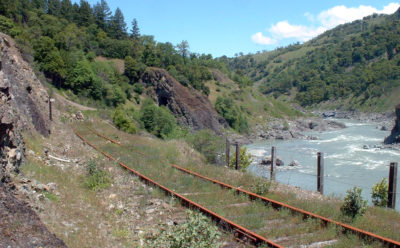California Supreme Court Issues Split Decision in CEQA Preemption Case
Justices Find CEQA’s Application to Public Railroad Projects Not Fully Preempted
The California Supreme Court has ruled in an important case that the California Environmental Quality Act (CEQA) is not fully preempted when it comes to publicly-owned railroad projects in the Golden State. Friends of the Eel River v. North Coast Railroad Authority. In that decision, the justices forged a middle ground between the more extreme arguments advanced by the litigants– producing a judicial compromise that is unlikely to satisfy fully either side. The Friends of the Eel River case seems likely to generate further litigation to discern the precise scope of federal preemption of CEQA’s application to other public rail initiatives–including California’s controversial High Speed Rail Project.

Friends of the Eel River arises out of public efforts to reestablish freight rail service over a long-abandoned private railroad line operating between Napa County and Arcata in northwest California. To facilitate that goal, the California Legislature in 1989 created the North Coast Railroad Authority, a public entity charged with responsibility to rehabilitate the line, and to own and operate transportation services on it prospectively. As part of those efforts, the NCRA initially undertook an environmental review of this public works project under CEQA. In 2013, however, the NCRA reversed course, for the first time taking the position that application of CEQA to the project is preempted by federal law–specifically, the Interstate Commerce Commission Termination Act (ICCTA) of 1995.
Opponents of the North Coast rail project challenged the NCRA’s preemption claim in court. Both the trial court and the Court of Appeal for the First Appellate District agreed with NCRA that the ICCTA fully preempted CEQA’s application to the railway project. The Supreme Court granted review, presumably at least in part because state Courts of Appeal had reached inconsistent results regarding ICCTA preemption of CEQA.
In a lengthy and complex 6-1 decision authored by Chief Justice Tani Cantil-Sakauye, the California Supreme Court reversed, concluding that the ICCTA does not fully preempt CEQA’s application to publicly-owned California railroad projects.
The Court began by invoking the longstanding principle that federal preemption of state law is not to be presumed, and that a presumption of validity applies to such laws, especially when they involve “internal, sovereign concerns of the states.”
The decision then examined the ICCTA in detail. The Court characterized this federal law as “both unify[ing] the rail industry into a national system subject to unitary federal regulation, and also deregulat[ing] the industry.” The opinion further notes that Congress inserted a broadly-worded provision expressly preempting much state and local government regulation of railroads, in favor of federal oversight.
At this point, the Friends of the Eel River decision proceeds to discuss an issue not technically before the Court: whether CEQA’s application to private railroad operations is preempted by the ICCTA. Chief Justice Cantil-Sakauye’s majority opinion has no difficulty concluding that CEQA’s application to privately-operated railroads is preempted–at least in cases where application of CEQA “would have the effect of halting a private railroad pending environmental compliance.” (In reaching this conclusion, the Court relied upon the U.S. Court of Appeals for the Ninth Circuit’s 1998 decision in City of Auburn v. United States, holding that Washington State’s CEQA-like environmental review statute is preempted by the ICCTA when it comes to private railroads in that state.)
Turning to the publicly-owned railroad project directly at issue in Friends of the Eel River, however, the justices reach a quite different result. When it comes to railroad projects owned and operated by the State of California or its political subdivisions, said the Court, the ICCTA does not totally preempt CEQA.
The Supreme Court justified this latter conclusion in two ways. First, the Court interpreted the ICCTA’s express preemption provision as not superseding “all historic state police powers over health and safety or land use matters, to the extent state and local regulations and remedies with respect to these issues do not discriminate against rail transportation, do not purport to govern rail transportation directly, and do not prove unreasonably burdensome to rail transportation.”
The justices’ second rationale for not finding blanket CEQA preemption with respect to public railroad projects is more novel–and controversial. The majority reasoned that when the state applies CEQA to its own railroad projects or those of California local governments, it is not engaged in the type of traditional “regulation” that is expressly proscribed under the ICCTA. Instead, opined the Court, CEQA “operates as a form of self-government when the state or a subdivision of the state is itself the owner of the [railroad] property and proposes to develop it.” This portion of the decision concludes, “It appears to us extremely unlikely that Congress, in enacting the ICCTA, intended to preempt a state’s adoption and use of the tools of self-governance in this situation…”
Accordingly, the Supreme Court remanded the case to the Court of Appeal “for further proceedings consistent with this opinion.”
Supreme Court Justice Corrigan issued a solitary dissent, stating that she would find CEQA’s application to both private and public railroad projects like NCRA’s preempted by the ICCTA. Her principal disagreement was with the majority’s self-governance v. regulation distinction summarized above. “I do not follow that logic,” declared Justice Corrigan. She criticized the Court’s holding on this point as “based not on settled law but on an entirely novel theory construing regulation as a form of `self-governance.'”
There are several reasons why the Friends of the Eel River decision is significant. First, it is the first case in the 47-year history of CEQA in which the California Supreme Court has been called upon to decide whether that bedrock state environmental statute is preempted by federal law. And it continues an overall pattern of the Supreme Court to resist finding that California statutes are preempted by federal law. (Federal courts, in contrast, are relatively more willing to find state statutes and regulations preempted by federal authority.)

Second, the Supreme Court was unquestionably looking beyond the facts of Friends of the Eel River in issuing its decision in this case. That’s in part because two California Courts of Appeal had issued conflicting opinions on the issue of the ICCTA’s preemption of CEQA’s application to publicly-owned railroads. Contrary to the Court of Appeal’s now-vacated finding of broad preemption in Friends of the Eel River, another Court of Appeal in Sacramento recently held that CEQA is not preempted with respect to California’s High Speed Rail Project.
While that conflict has now been resolved by the Supreme Court’s recent decision, the controversy over the ICCTA’s potential preemption of CEQA remains alive and well. That’s because the Surface Transportation Board, a federal agency created by Congress and charged with administering the ICCTA, in 2014 issued an administrative ruling finding that CEQA’s application to the High Speed Rail Project is broadly preempted by the ICCTA. That agency decision has been appealed by Central Valley opponents of High Speed Rail to the Ninth Circuit Court of Appeals; that court heard oral arguments in the case last month. A decision by the Ninth Circuit upholding the STB administrative ruling in favor of federal preemption would create a clear conflict with the California Supreme Court’s Friends of the Eel River case. Such a conflict would in turn undoubtedly prompt a petition to the U.S. Supreme Court by the losing party in one or both cases to resolve that conflict, and also substantially increase the chances that the High Court would agree to do just that.
A final observation is that Friends of the Eel River continues the recent trend of recent California Supreme Court CEQA decisions to spurn “bright-line” opinions providing clear direction to lower courts and CEQA litigants, in favor of fact-bound, complex “balancing test” decisions offering precious little guidance for future cases. The Friends of the Eel River decision leaves considerable uncertainty as to the precise scope of ICCTA preemption of CEQA regarding both private and public railroad projects in California. That uncertainty will doubtless spawn more lawsuits on this same issue in the future.
Whatever else one thinks of Justice Corrigan’s dissenting opinion, it has the virtue of brevity and clarity–two features noticeably absent from the majority’s important but opaque decision in Friends of the Eel River.
UPDATE: On August 2nd, the Ninth Circuit Court of Appeals dismissed for lack of jurisdiction the above-referenced appeal of the Surface Transportation Board’s sweeping administrative determination finding ICCTA preemption of CEQA with respect to California’s High Speed Rail Project. (Kings County v. Surface Transportation Board.) The STB order, opined the Ninth Circuit, was “purely advisory and, therefore…not final.” This dismissal eliminates the possibility of a Ninth Circuit-California Supreme Court conflict on the question of federal preemption of CEQA when it comes to railroad construction and operation. That, in turns, makes it unlikely that the U.S. Supreme Court would grant review of the California Supreme Court’s Friends of the Eel River decision.







Reader Comments